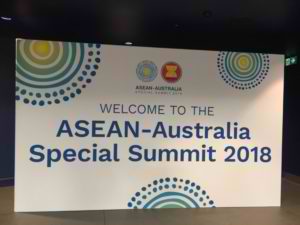 A number of new education initiatives were announced at the #ASEANinAus Special Summit by The Hon Julie Bishop MP, Minister for Foreign Affairs.
A number of new education initiatives were announced at the #ASEANinAus Special Summit by The Hon Julie Bishop MP, Minister for Foreign Affairs.
Questions were asked such as could Australia one day actually be part of ASEAN? Perhaps it is a long shot but it would be the world’s 4th largest economy so it is important to consider.
The Hon Steven Ciobo MP, Minister for Trade, Tourism and Investment, said that the ASEAN is a wealth of business opportunities building relationships with the ten countries of ASEAN to promote digital trade and support inclusive economic growth in our region.
On connecting new markets in the ASEAN region, “Tech is bringing down a lot of walls… we may see a cost effective ‘beam me up Scotty’ service, or hyperloop”, says Tony Fernandes, CEO of Air Asia. Cities in the ASEAN must be considered, not just countries as they each have a different growth story, with e-commerce a huge opportunity. Priorities were shared from Philippines, Vietnam and Indonesia with a selfie after the panel taken from the stage in Sydney at the International Convention Centre.
Networking connections and meetings took place over lunch at the #ASEANinAus SME conference, with a buzzing marketplace and people participating from across all 10 ASEAN countries. With insights such as, Vietnam’s dynamic environment is reflected in a young population, growing wealth, changing consumer attitudes and greater mobility.
A panel across big business, SMEs, Industry 4.0 and supply chains including friends from Indonesia and Australia, “Technology development is a good news story for SMEs. It lowers the hurdles and it lowers the costs”, said Dr Stephanie Fahey from Austrade.
“In Cambodia, companies are jumping the phase of websites – they just use social media for marketing!”
There is an absolute imperative need for SMEs to go global, or risk getting ‘gobbled up by someone else who does’ and a new class of assets emerging. Industry utility assets in a cyber-physical connected world where cyber security is an important focus.
“Leaders need to be prepared to be ‘reverse-mentored’. The younger generation are more tech savvy in the digital economy.”
More Australian businesses are choosing to export goods to ASEAN than to China, the United States or the European Union, why? The ASEAN region’s economy is already equivalent to the 5th largest in the world.
Advice from those who are working with ASEAN countries, “Do your research first. Step into the market with the support of agencies such as Austrade, EFIC, state/territory governments and countries chambers of commerce. The audience heard numerous stories and strategies to market with landing pads and partnerships hubbing through one ASEAN country to expand to others in the region.
 At the networking reception, CSIRO’s Data61 released a new report, titled ‘Sunrise industries’ to transform the ASEAN region’. The Sunrise Industries identified in the new report include:
At the networking reception, CSIRO’s Data61 released a new report, titled ‘Sunrise industries’ to transform the ASEAN region’. The Sunrise Industries identified in the new report include:
Artificial intelligence and autonomous systems. Made up of large and small companies which design, construct, implement and operate automated systems, this industry emerges as a result of the increasing capabilities of automation and artificial intelligence to deliver benefits at lower costs.
Financial and regulatory services technology. Enabled by technology and growing demand for innovative financial services, the FinTech and RegTech sector is made up of companies that provide digitally enabled financial and regulatory products and services.
High value nutrition. Growing incomes, rates of chronic diseases and concerns about food safety and provenance have driven demand for healthy, traceable and trustworthy food products that are sustainably and ethically produced, giving rise to an industry focused on high value nutrition.
Next generation energy storage and distribution. Improvements in the affordability and capability of batteries, other technological innovations, and consumer demand for clean energy solutions are fuelling demand for companies (both big and small) in the energy storage and distribution market.
Cyber-physical systems security. While cyber-physical systems (i.e. systems which have intertwined software and physical components) are becoming increasingly widespread, they can be vulnerable to hacking, creating new opportunities for the cyber-physical systems security industry.
Personal health and ageing. Rapidly aging populations are creating demand for products and services related to personal health and ageing (e.g. apps, wearable devices and mobile/telehealth services) along with personalised health and aged care.
Digital infrastructure and connectivity. While the wider Asia Pacific region has some of the world’s most digitally advanced nations, digital infrastructure is still lacking for many ASEAN members, creating opportunities for the digital infrastructure industry to respond to the growing connectivity demand.
The funniest quote at the conference was, “Australians are often surprised to learn that they have a ‘culture’ and when meeting delegations or travelling for business overseas, coaching and mentoring is key.
You never know who you are going to meet at international networking events so just say hello and go from there – you might surprise yourself!


